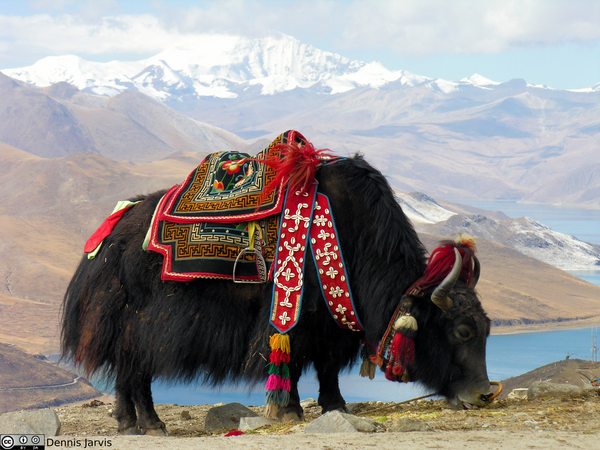Know Your Fiber: Yak
Posted on August 01 2017

Yak is a relatively recent addition to the fibers easily available to the knitters, crocheters, spinners and weavers on this side of the world. The undercoat of the yak, known as yak down, is making inroads in local fiber arts stores throughout North America. Yak down has a micron measurement similar to cashmere, which means that yarn made from this luxury fiber is one of the softest and most snuggly fibers you can find.
Domesticated yaks are found in the higher altitudes in Central Asia, as far south as the Himalayas, across the Tibetan Plateau, and as far north as Mongolia and nearby parts of Russia. Due to their physiology, they can only thrive in these highlands. The earliest available records show that yaks were already domesticated by 8 BCE by the nomadic Qiang people on the Tibetan Plateau, who were instrumental in spreading domesticated yak along with other aspects of their culture throughout the Central Asia region. However, the process of domesticating wild yaks is thought to have begun as much as 10,000 years earlier, with evidence of trade showing around 2800 - 2300 BCE.
Although nomadic culture in Central Asia has waned in some countries, it remains a living culture in others, such as in Mongolia. Yaks today are raised throughout Central Asia largely by nomadic people, and on small farms by people who don’t live a nomadic life. They are still used the same way they have been used for thousands of years – for milk, meat, dung for fuel, hides, and fiber. They are also used as pack animals by nomadic tribes, and as plow animals for farmers.
Yak and cashmere goats are both raised as fiber animals by nomads in the highlands of Central Asia. Cashmere goats, unfortunately, are quite rough on the grasslands, causing damage by roaming the grazing lands with sharp hooves that tear up the ground and by their method of grazing which rips up plants by the roots. This has turned some areas' grasslands into barren areas, not able to support either yak or goats. Yaks on the other hand, have feet that are gentler on the grasslands, and their grazing only removes the top of plants, ensuring that the plant can continue to grow after the yaks have moved on. In an effort to prevent this continued destruction of their grasslands, some groups of nomads have decided to return to raising yak and selling the down as a luxury fiber. Here at Northwest Yarns, we are happy to support this endeavor, and we are constantly looking to add new yak fiber and yarns to our inventory.
Three different types of fiber can be harvested from yaks. The coarse, longer hairs are used by nomads to make tents. Medium thickness yak fiber is used to make ropes, tents, and sturdy blankets. The softest fiber, the undercoat, is called yak down and is used to make yarn. Yak down has a diameter of 15-20 microns. To compare, cashmere has a diameter no larger than 19 microns.
Yak down is hypoallergenic, and is very warm while remaining breathable. It also has a wonderful drape along with good elasticity. It is a luxury fiber for both its amazing softness and limited availability; each yak only produces 1 kilogram of down per year. As a short staple fiber, it is frequently blended with wool or other fibers in commercially available yarns to produce a wonderful product with superior softness. However, all our spinners out there have also enjoyed spinning 100% yak yarn using short staple fiber spinning techniques.
If you are interested in working with this amazing fiber, please stop by the store or visit our website. We have yak yarns and spinning fiber just waiting to be used in your next project!
Domesticated yaks are found in the higher altitudes in Central Asia, as far south as the Himalayas, across the Tibetan Plateau, and as far north as Mongolia and nearby parts of Russia. Due to their physiology, they can only thrive in these highlands. The earliest available records show that yaks were already domesticated by 8 BCE by the nomadic Qiang people on the Tibetan Plateau, who were instrumental in spreading domesticated yak along with other aspects of their culture throughout the Central Asia region. However, the process of domesticating wild yaks is thought to have begun as much as 10,000 years earlier, with evidence of trade showing around 2800 - 2300 BCE.
Although nomadic culture in Central Asia has waned in some countries, it remains a living culture in others, such as in Mongolia. Yaks today are raised throughout Central Asia largely by nomadic people, and on small farms by people who don’t live a nomadic life. They are still used the same way they have been used for thousands of years – for milk, meat, dung for fuel, hides, and fiber. They are also used as pack animals by nomadic tribes, and as plow animals for farmers.
Yak and cashmere goats are both raised as fiber animals by nomads in the highlands of Central Asia. Cashmere goats, unfortunately, are quite rough on the grasslands, causing damage by roaming the grazing lands with sharp hooves that tear up the ground and by their method of grazing which rips up plants by the roots. This has turned some areas' grasslands into barren areas, not able to support either yak or goats. Yaks on the other hand, have feet that are gentler on the grasslands, and their grazing only removes the top of plants, ensuring that the plant can continue to grow after the yaks have moved on. In an effort to prevent this continued destruction of their grasslands, some groups of nomads have decided to return to raising yak and selling the down as a luxury fiber. Here at Northwest Yarns, we are happy to support this endeavor, and we are constantly looking to add new yak fiber and yarns to our inventory.
Three different types of fiber can be harvested from yaks. The coarse, longer hairs are used by nomads to make tents. Medium thickness yak fiber is used to make ropes, tents, and sturdy blankets. The softest fiber, the undercoat, is called yak down and is used to make yarn. Yak down has a diameter of 15-20 microns. To compare, cashmere has a diameter no larger than 19 microns.
Yak down is hypoallergenic, and is very warm while remaining breathable. It also has a wonderful drape along with good elasticity. It is a luxury fiber for both its amazing softness and limited availability; each yak only produces 1 kilogram of down per year. As a short staple fiber, it is frequently blended with wool or other fibers in commercially available yarns to produce a wonderful product with superior softness. However, all our spinners out there have also enjoyed spinning 100% yak yarn using short staple fiber spinning techniques.
If you are interested in working with this amazing fiber, please stop by the store or visit our website. We have yak yarns and spinning fiber just waiting to be used in your next project!

Follow US